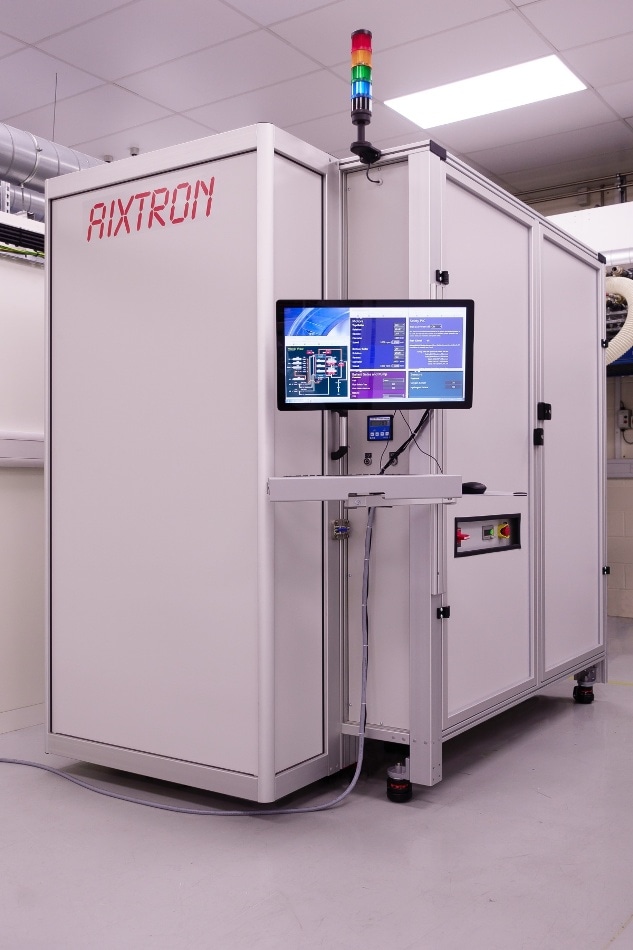Jun 28 2019
AIXTRON, Graphene Flagship’s partner, announced the outcomes of two of its systems that facilitate the large-scale synthesis of graphene through chemical vapor deposition (CVD).
 From prototypes to products: AIXTRON’s new systems enable cost-effective and large-scale production of graphene and related materials by chemical vapor deposition. Today, Graphene Flagship industrial partner AIXTRON showcased two new systems that enable cost-effective graphene production for a myriad of applications—such as consumer electronics, sensors, and photonics. The new devices allow the production of graphene under ambient conditions, and bring the cost of graphene films down by two orders of magnitude. (Image credit: Graphene Flagship)
From prototypes to products: AIXTRON’s new systems enable cost-effective and large-scale production of graphene and related materials by chemical vapor deposition. Today, Graphene Flagship industrial partner AIXTRON showcased two new systems that enable cost-effective graphene production for a myriad of applications—such as consumer electronics, sensors, and photonics. The new devices allow the production of graphene under ambient conditions, and bring the cost of graphene films down by two orders of magnitude. (Image credit: Graphene Flagship)
The neutron is a roll-to-roll system with the potential to deposit large areas of graphene on metal foils under ambient conditions. The CCS 2D system facilitates wafer-scale synthesis of graphene on insulating wafers, a major progress that will accelerate the development of new graphene electronics. In order to exhibit the cost-effective nature of the synthesized graphene, AIXTRON distributed samples at the Industrial Forum.
The novel Neutron system has the capacity to produce up to 20,000 square meters of graphene in a year—this is nearly 200 times the production capacity of conventional reactors that are currently used.
According to Alex Jouvray, Programme Manager at AIXTRON and Graphene Flagship Work Package Leader for Production, “Neutron is the product that resulted from of over three years of R&D, which included the demonstration of roll-to-roll graphene growth during the first stages of the Graphene Flagship project.” Neutron enables the synthesis of large areas of graphene beyond academic circles and on the factory floor.
The foil that is coated with graphene enters and exits the Neutron system under ambient conditions. Since it doesn’t need a vacuum, the Neutron can be easily placed inline at graphene manufacturing plants.
Alex Jouvray, Programme Manager, AIXTRON
Large-area monolayer graphene synthesized using this innovative method could be applied to wearable devices, transparent conductors, and coatings. “Moreover, it’s economical,” added Jouvray. “With Neutron, we are able to bring the cost of a square meter of graphene CVD films down by two orders of magnitude,” he explained. “It’s a game-changer.”
The all-around CCS system targets semiconductor applications. In this case, there are rigorous contamination demands; in general, it is necessary to grow graphene on metallic surfaces and foils, which are non-flat and hence are difficult to handle in the semiconductor industry and consist of metal contamination that needs further cleaning steps before the material makes it to a fab.
In the initial years of the Graphene Flagship project, AIXTRON collaborated with the team of Camilla Coletti at Graphene Flagship partner Istituto Italiano di Tecnologia (IIT) and scaled the growth of graphene on insulators to full wafer-scale on its CCS 2D reactor, which can house wafers of 2 to 8 inches. The wafers have low contamination levels that fulfill the demands of semiconductor fabs immediately after growth.
According to Camilla Coletti, “such tremendous progress is only possible thanks to the Graphene Flagship project which brings together top scientists from academia and engineers from a world-leading equipment company.” In addition, the system has the potential for large-scale production of other layered materials, for example, boron nitride or transition metal dichalcogenides.
Kari Hjelt, Head of Innovation of the Graphene Flagship, believes that “these systems developed by AIXTRON show how our investment into prototypes during the first years of the Graphene Flagship are leading to products that enable mass production of graphene by chemical vapour deposition.” He added that “these discoveries open up thousands of possibilities beyond graphene, the arrival of wafers featuring other layered materials, or even ‘sandwich’ heterostructures are just around the corner.”
The ultimate aim of the Graphene Flagship is to bring graphene and related layered materials from the lab to the factory floor. To take these new materials to the traditional semiconductor fabs, which is key to achieve their widespread application in consumer electronics, photonics and sensors, industrial tools capable of large area, large rate and low-cost manufacturing of graphene and related materials are needed.
Andrea C. Ferrari, Science and Technology Officer, Graphene Flagship
Ferrari is also the Chair of Graphene Flagship’s Management Panel.
“With these systems,” added Ferrari, “Graphene Flagship Partner AIXTRON leads the way fostering the new market opportunities that these new materials open. The ability to produce large scale graphene viably is of particular importance as the Graphene Flagship gears up to launch the first Graphene Foundry. Moreover, these products are a cornerstone in the innovation and technology roadmap of the Graphene Flagship, and shows that we are set to achieve the ambitious goals for our first ten years.”